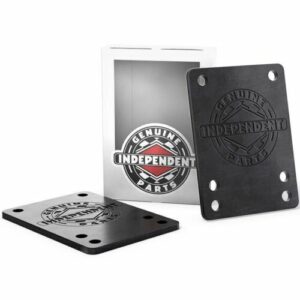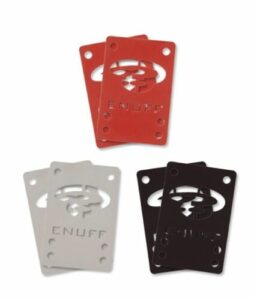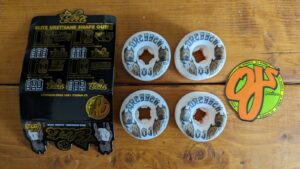Some skateboarders find riser pads essential (I absolutely do) and for others it’s just extra weight with no benefit, so what’s the deal man? I will break down the riser pad and shock pad in this article, so hopefully you’ll know if you want them or should use them by the end.
What is a skateboard riser pad?
Riser pads are normally rectangular pads that sit between your deck and trucks. For most skateboarders they will also be relatively flat, however it is possible to also get angled riser pads.
The purpose of riser pads is to increase the distance of the skateboard deck from the ground (hence the name ‘riser’, and in theory provide you with a little more room to explore your pop. This raising of the deck can also increase your ability to carve as you skate bowls and pipes.
I’ve never used angled riser pads, but from the bits I know, they can be taken advantage of for improving turning/leaning as you carve. I’d therefore advise to avoid them if you’re mainly skating street or park, but definitely explore an angled riser pad if you’re planning on skateboarding half pipes or bowls.

What’s the benefit of skateboarding with riser pads?
The first two have already been mentioned.
1. A raised skateboard potentially improves your carving
2. A raised skateboard may improve your pop.
However there are other benefits to putting something between your trucks and the deck, which act as more protective measures.
3. The riser pads not only raise your deck further off the ground, but also increases the distance between your skateboard wheels and the deck. This means that you then also minimise the risk of wheel bite. Just keep in mind, if you have 5mm riser pads and then add 5mm to your wheels you’ll be in the same position you started in, and could get wheel bite still.
4. This is the benefit that I tend to get when I use them. They slow down the cracks I get on my deck where the bolts are placed. Now I normally go through a deck once every 3-4 months (skating once a week), but without riser pads, I sometimes get cracks starting to appear within a week or two. I guess I’m a heavy skater, or just slam my feet down when I do flip tricks. Either way the riser pads are a good financial investment for me.
What does a skateboard riser pad look like?
I’ll focus on the most common skateboard riser pads, for pop sickle boards. They tend to be rectangular due to the base plate of your trucks being this shape. They will often have 4-6 holes in them for your bolts to get through, which is due to maximising compatibility. Old school and new school skateboards can have different spacing between bolts. They can come in a wide variation of colours, so you can normally get something to meet your style, for example I’ve seen black, green, orange, purple, white etc. Usually the part that gets sandwiched between your skateboard deck and skateboard truck will have a design on it, which is most often the logo of the manufacturer.
Note: if you put riser pads on your skateboard, you’ll likely need to increase the size of your bolts.
What sizes are skateboard riser pads?
I tend to ride a ¼” riser pad on each truck, but there are different sizes, and the size refers to the depth of the skateboard riser pad. You can get 1/8” up to ½” in size, and depending on the depth will depend on the size of your required bolts. I’d wager the thicker the depth of the pad, the greater the impact on some of the benefits listed above, but everyone skates differently so it’s best to try them out yourself.
What materials are skateboard riser pads made from?
Polyurethane (sometimes listed as urethane, or PU) is the primary material that skateboard riser pads are made from, but the specific combination of materials may vary by manufacturer, because some riser pads may be softer or harder, and some may last longer than others. I get the feeling that each company has it’s own technique, but generally the variation in materials would be very, very little.
Why not use a skateboard riser pad?
Honestly I think this is preference. The part that always surprises me, is that when you buy completes, they never come with riser pads. I’m not sure if this is just cost cutting, or if what I said above about boards cracking increases sales, or if it’s just that few people use riser pads. Maybe ask your local skate shop about them and find out why they don’t put risers on their completes? That being said, they are one of the cheapest parts of a complete skateboard when added. I think the only thing cheaper is the bolts.
What is a skateboard shock pad?
Within this article I have mentioned once or twice something called Shock pads. These are similar to Riser pads, but have subtle differences. Firstly they’re designed to absorb the shocks of heavy landings (maybe I should swap over?), and secondly they’re made of a softer material to achieve this absorbing process. Shock pads tend to be made of a foam or rubber.
Shock pads don’t cost much different to risers but they are less common, so hunting some down might be a challenge if you’re after a specific depth and colour.

Hopefully you now feel fully informed about skateboard riser pads and skateboard shock pads, so that you can make the correct decision regarding which you want, if you want any at all. Independent has some great choices for pads, so check them out. Also check out my review on Dressen OJ Wheels, they might be a great choice for you.

